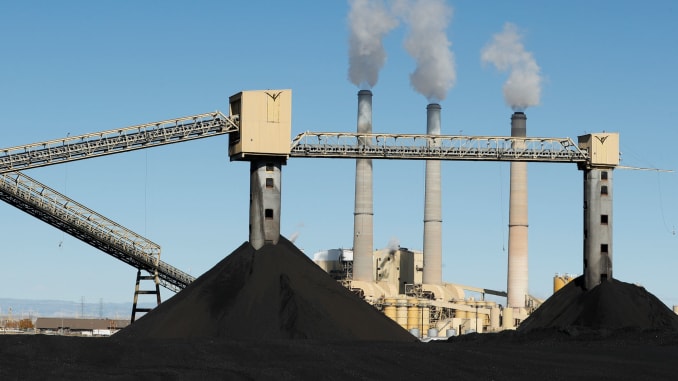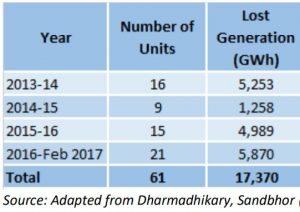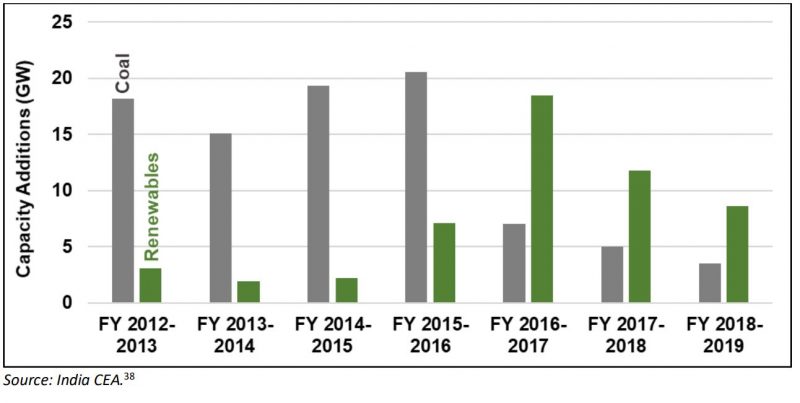Water Stress Threatening Coal Expansion Along with RE: IEEFA

India’s coal-based power generation has taken a hit due to the countrywide water scarcity, this was revealed in the latest Institute for Energy Economics and Financial Analysis (IEEFA) report titled-Risks Growing for India’s Coal Sector. This is pretty much the issue with which the solar power industry is facing as well.
The report highlights 3 major challenges that could intensify the problems for coal sector’s power generation:
- Over-building of coal-fired capacity. The boom in coal plant construction during the early 2010s has resulted in significant over-capacity. The amount of installed coal-fired capacity in India is now 20 percent higher than the country’s peak demand level and fully 50 gigawatts (GW) above average demand levels.
- Declining water supplies. Groundwater levels across India are in decline. Since 2012, both total annual rainfall and monsoon rainfall have generally been below normal levels ‒ a major concern for coal generation, which requires substantial amounts of water for steam production and cooling.
- Increasing competition from renewables, particularly during the monsoon season. Low-cost renewable energy has a great advantage during the monsoon season when coal generation dips while wind and hydro generation peak.

Due to the government’s push to meet the Paris climate targets, country’s energy sector is undergoing a phase of change which have been exacerbated by fluctuating water and stranded assets causing loss of generation and revenue. We all know the scale of non-payment of dues that the discoms have amassed by now.
Water Stress
But David Schlissel, the co-author and IEEFA’s director of resource planning analysis, says that water remains its top worry. ”The energy landscape has changed dramatically in recent years and there are increasing stressors, particularly on the thermal coal sector, that require urgent attention, water being one of the most prominent,” said Schlissel.

February 2017
Climate change has been attributed as the core of the issue, as it affects both flooding and droughts. Ongoing water shortage problems in India forced 61 plant shutdowns from 2013-2017, resulting in roughly 17,000 gigawatt-hours of lost generation (and revenue).
“India’s overbuilt coal power capacity has left two related problems. First, utilisation rates have fallen, impairing the economic competitiveness of coal plants because they must spread their costs over a diminishing number of kilowatt-hours,” said Bryndis Woods, researcher at the Applied Economics Clinic (AEC) and co-author of the report. “Second, over-capacity has burdened the system as a whole since the plants’ capital costs still need covering even if their electric output is not needed.”
About 41 GW of India’s installed thermal capacity is located in drought-affected areas, with about 37 GW located in “extreme drought” areas, according to the report.
Renewable Energy
Another major competition has been the introduction of renewable energy. India has set ambitious targets like 175 GW of renewable energy till 2022 and 275 GW by 2027 and as much as 500 GW by 2030.
Prices for onshore and offshore wind and solar are expected to continue declining while prices for coal-fired generation are likely to rise. All solar and wind auction prices in India since June 2018 have come in below 3.29 Rs/kWh, less than the average FY 2018-19 price of coal-fired electricity (3.46 Rs/kWh, equal to US$0.045/kWh) from NTPC—the state-run utility that operates 53GW of coal-fired capacity.

to FY 2018-19
“The economics already favour renewables, and we expect the cost disparity between renewables and coal to widen as time goes on,” said Schlissel.
The report has made four policy recommendations:
- India should adopt a policy of no net new coal-fired power generation beyond what is already under construction.
- Plants under construction should be reviewed for possible cancellation.
- An economic assessment should be conducted of the nation’s oldest coal-fired power plants to determine their financial viability, including the cost of retrofitting with pollution controls. A phased, end-of-life closure plan needs to be prepared and implemented.
- Coal capacity in the most drought-stricken areas must be addressed as a priority. This capacity should be replaced with low-cost renewable resources. Accelerated investment in interstate grid transmission capacity expansion and modernisation is required to build national grid reliability and accommodate low-cost but variable renewable energy.
To read the report in detail, click here




